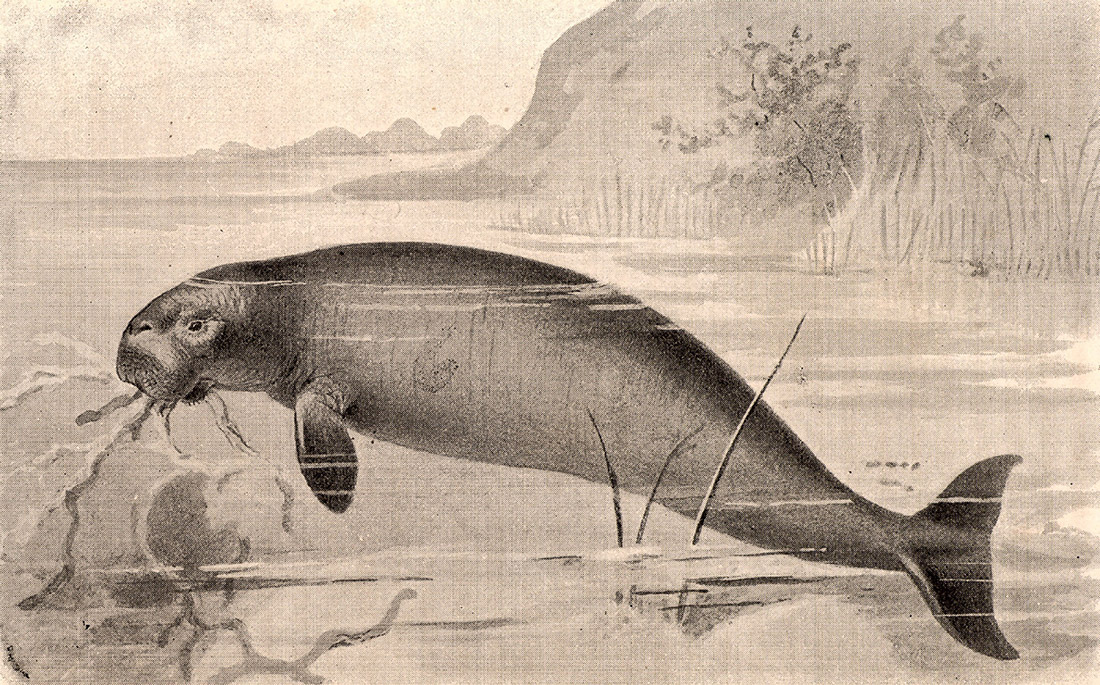Headless Skeleton of Extinct Sea Cow Unearthed in Siberia

An unusually complete — albeit headless — skeleton of a Steller's sea cow was recently found in northeast Russia. Despite the missing noggin, the remains may help researchers solve several mysteries about this enormous, extinct animal.
For instance, researchers aren't sure how many vertebrae (the bones that make up the backbone) the Steller's sea cow had, and they aren't certain what its flippers looked like, said Daryl Domning, a professor of anatomy and a Steller's sea cow expert at Howard University in Washington, D.C., who is not involved with the new finding.
It's not clear from the preliminary description posted online, but "it's the first possibly complete skeleton of the forelimb of the flipper," Domning told Live Science. "It's quite a remarkable specimen from the looks of it." [Sirenian Gallery: Photos of Cute Sea Cows]
Researcher Marina Shitova found the Steller's sea cow (Hydrodamalis gigas) during a routine survey of the coastline of Komandorsky Nature Reserve. She noticed the dead creature's ribs poking out from the sand and pebbles. A few days later, the reserve's staff returned to excavate the bones, which took eight people a total of 4 hours to uncover, according to a statement from the reserve.
The skeleton measured 17 feet (5.2 meters) long. But given the length of its missing parts (including the head), the Steller's sea cow likely measured nearly 20 feet (6 m) when it was alive, or about the length of a modern killer whale, the researchers said.
It's extraordinary that the newly uncovered specimen is so complete, Domning said. Over the past 200 years, researchers have found bits and pieces of H. gigas remains. Because they had few complete specimens, researchers put together bones from multiple individuals to make mounts for museums, including the mount at the Smithsonian National Museum of Natural History in Washington, D.C., which was built in the 1890s, he said.
The last time researchers found a nearly complete Steller's sea cow skeleton was 30 years ago, when an almost 10-foot-long (3 m) specimen was discovered on Bering Island, Russia, he said. "But it's not nearly as complete as this [newly discovered] one."
Sign up for the Live Science daily newsletter now
Get the world’s most fascinating discoveries delivered straight to your inbox.
The newfound skeleton will go on display at the Komandorsky Nature Reserve visitor center, according to the statement.
Rapid extinction
The Steller's sea cow went extinct in 1768, a mere 27 years after it was first discovered by Western science.
Like many species, it was discovered by accident. A Russian Navy expedition, led by the Danish explorer Vitus Bering, became shipwrecked in 1741 on the then uninhabited Commander Islands. The surviving crew, including the German naturalist Georg Wilhelm Steller (1709-1746), spent the winter there, and later escaped by building a smaller boat out of the wreckage of their ship, Domning said.
During that long, cold winter on what was later named Bering Island, Steller discovered the sea cow, and even dissected one that had been killed. The beast was so big, Steller had to bribe sailors to help him move it, and he had to constantly deal with arctic foxes that were trying to eat the carcass and steal his pens and paper, Domning said.
Even so, Steller managed to dissect the sea cow and write detailed descriptions of its anatomy and habits, Domning said.
Upon their return, the Russian crew wasted no time in sharing the news that they had discovered a place replete with otters and fur seals. Hunters soon swarmed the area, killing otters and seals for pelts and the Steller's sea cow for meat and leather, rapidly hunting it into extinction. [Under the Sea: Life in the Sanctuaries]
However, the story is more complex than that, Domning said. H. gigas ate kelp, a brown and reddish-colored alga. But so do sea urchins. When hunters killed the region's otters, the otters could no longer eat the urchins. Soon enough, the urchin population boomed, competing with H. gigas for algae.
"They [the Steller's sea cow] were being starved at the same time they were being hunted," Domning said.
Now, researchers can learn about the Steller's sea cow only by studying its remains, which are found in the North Pacific region. Skeletal analyses show that the species is closely related to dugongs (Dugong dugon) and more distantly related to manatees (Trichechus), Domning said.
"I'd give anything to have specimens of that animal alive today just so we could learn more about what their physiology is like and everything else," Domning said. "But we'll never be able to answer a lot of those questions."
Original article on Live Science.

Laura is the archaeology and Life's Little Mysteries editor at Live Science. She also reports on general science, including paleontology. Her work has appeared in The New York Times, Scholastic, Popular Science and Spectrum, a site on autism research. She has won multiple awards from the Society of Professional Journalists and the Washington Newspaper Publishers Association for her reporting at a weekly newspaper near Seattle. Laura holds a bachelor's degree in English literature and psychology from Washington University in St. Louis and a master's degree in science writing from NYU.









